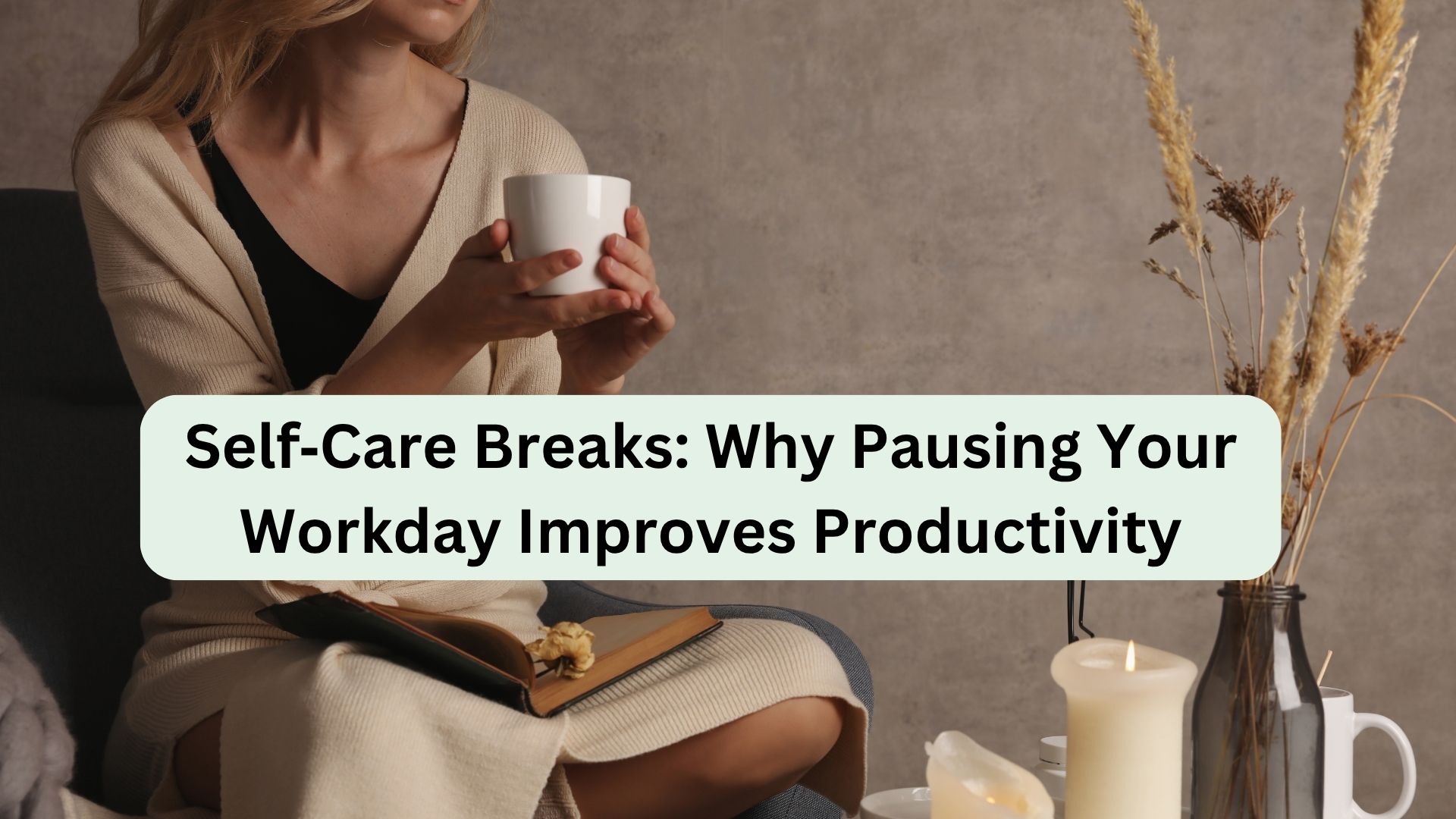Ever feel like you’re sprinting through your workday only to crash into napland by lunchtime—no gold medal, just groggy eyes and a slice of regret?
That’s me most days, especially juggling deadline-chasing tasks around school runs, teen drama, and trying to squeeze in a moment to sniff a fresh cup of coffee only to realize it’s been reheated three times. But what if I told you that pausing the madness—the infamous self‑care break—might actually make you more productive?
Yes, you read that right. The secret sauce isn’t more work—it’s strategic pausing. Let’s dive into why self‑care breaks aren’t just fluffy Instagram quotes—they’re scientifically backed productivity boosters, lubricators of creativity, and sanity-savers for us multi-tasking mums and remote-worker warriors.
1. What Are Self‑Care Breaks (and What They Aren’t)
Self‑care breaks are intentional pauses during your workday where you step away from your screen, tasks, or deadlines and do something that refreshes your mind, body, or soul. Here’s what they’re not:
- Not just scrolling through Instagram until you realize you’ve been down the rabbit hole for 20 minutes.
- Not an excuse to delay work by binge-watching your favorite show (tempting as it is!).
- Not something only wellness gurus or celebs can do.
They are, however:
- A short reset—mental, physical, or emotional.
- Breaks that have a clear start and end time (we’ll chat timing soon).
- Customizable to your needs—naptime, 1-minute stretching, journaling, dance break, or stepping outside to inhale fresh air.
2. The Science Behind Pausing: Breaks = Burns (Bad moods, brain fog, burnout)
Mounting evidence shows pausing boosts performance, improves mood, and refuels creativity. Here’s what the research says:
| Study / Source | What They Found |
|---|---|
| University of Illinois | Focus naturally wanes after ~50–90 minutes. Short breaks can restore attention and improve productivity. |
| NASA researchers | Breaks during long tasks improve mentality & performance more than working straight through. |
| Stanford University | Taking purposeful breaks increases both productivity and well-being. |
| Journal of Occupational Health Psychology | Interrupting work for self‑care improves emotional regulation and decreases burnout risk. |
👉 Big takeaway: Continuous work = diminishing energy + decision fatigue + crankiness = burnt‑out you who may pay bills but doesn’t feel like a functioning human.
3. Types of Self‑Care Breaks & When to Use Them
Here are break styles you can sprinkle throughout the day:
A. Micro‑breaks (1–5 minutes)
- Best scheduled every 30–45 minutes.
- Examples: Neck and shoulder stretches, stepping outside for sunlight, eye‑rest exercises, 10 deep breaths.
B. Mini‑breaks (10–15 minutes)
- Use every 90–120 minutes or after finishing a big task.
- Examples: Short walk, quick journaling sessions, mindful tea breaks, dance‑off challenge with your kids, or a gratitudes check‑in.
C. Mid‑day “Reset” Break (30–60 minutes)
- Usually at lunch time, between morning and afternoon slog.
- Examples: Power nap, guided meditation, podcast while gardening or cooking, call a friend or teen for their latest scoop.
D. Evening “Decompression” Break
- After your official workday ends.
- Examples: Warm bath, bedtime reading, gentle yoga, skincare routine, turning off screens by candlelight.
4. How Self‑Care Breaks Improve Work Performance
- Boost Focus & Efficiency
- A short pause restores cognitive resources, so returning to tasks feels like jumping back on a refreshed hamster wheel.
- Enhance Mood & Emotional Resilience
- A walk, hug from your teen, or snack can lift spirits and reset the mood meter.
- Increase Creativity & Problem-Solving
- Stepping away lets your subconscious figure things out—we’ve all had “aha!” moments in the shower, right?
- Prevent Burnout
- Regular recharging reduces stress hormones and gives you stamina for the long haul.
- Better Relationships
- Less snappy you = nicer, more present partner and teens. Bonus for domestic harmony!
5. Real‑Life Examples That Worked
- Home‑office freelancer “Lynn” uses the Pomodoro technique. She works for 25 minutes, breaks for 5 with neck stretches, and after four cycles she takes a 30‑min break. She’s reduced eye strain and improved deadline delivery.
- Remote‑worker mum “Tara” does a 5‑minute gratitude journaling pause in the afternoon. It helps shift her mood and mood‑shifts her to finish the day strong.
- Freelance marketing mum “Jess” takes a midday 45‑min power nap. It sounds indulgent—but she gains 2 more productive hours in the afternoon and feels way happier in parent‑teen conversations.
6. Fun Break Ideas for WFH Mums & Freelancers
- Dance to a 3‑min upbeat song – Instant mood booster.
- Mindful tea/coffee sip – Focus on aroma, warmth, taste.
- One‑page free‑write – Dump your thoughts, clear mental clutter.
- Picture time – Flip through photobook or browse family pics.
- Yoga pose – Try Child’s Pose or Cat–Cow sequence.
- Snack break with purpose – Hydrate and nosh: apple slices, nuts, or dark chocolate.
- Open‑air moment – Step outside, stare at the sky, breathe deeply.
- Gratitude list – Three small wins or positive things in your day.
- Play with pets/ kids – 5‑minute chase, tickle fight, or cuddle.
- Short guided meditation – Apps like Headspace, Calm, or 3‑min on YouTube.
7. How Often & How Long: A Handy Schedule
| Time of Day | Work Scalar | Break Style | Suggested Length | Sample Activity |
|---|---|---|---|---|
| 9:00 AM | Start | Mini‑break | 3‑5 min | Window stretch + glass of water |
| 10:30 AM | After task | Micro‑break | 2 min | Caffeine sip + look at greenery |
| 12:00 PM | Midday | Reset break | 30 min | Power nap / lunch / short walk |
| 2:00 PM | Afternoon | Mini‑break | 5 min | Gratitude list + snack |
| 3:45 PM | After task | Micro‑break | 3 min | Gentle stretches |
| 5:00 PM | End of day | Decompress break | 30–60 min | Bath, journaling, reading |
8. Technology Tools to Support You
Here’s a quick tech breakdown for self‑care breaks:
| Tool/App | Break Type | What It Does |
|---|---|---|
| Pomodoro Timer | Micro‑breaks | Alerts every 25/5 minutes. Try “Focus To‑Do” or “Be Focused.” |
| Pipefy / Trello / Asana | Mini & Reset breaks | Help with task planning and boundaries for break triggers. |
| Calm / Headspace | Micro or Mini | 3‑10 min guided meditation. |
| Stretch Reminder (Mac/PC plugins) | Micro‑breaks | Pop‑up reminders to stretch/chair exercises. |
| Forest App | Focus blocks & micro‑breaks | Plant a digital tree — touchdown: you focus. |
9. Overcoming Guilt: Self‑Care Isn’t Selfish
For us mums and freelancers, the mental battle is real: “I should be working… I should be doing something.” But here’s a reality-check:
- Taking care of your mental and physical health is productive.
- You’re modeling healthy behavior for your teens.
- You actually get more done because you’re better recharged.
A little rebel mantra: “I pause to perform.”
Self‑care breaks are like charging your phone: would you feel guilty for charging? No. You do it because you need to. Your brain (and your work ethic) is the same.
10. Tips for Setting Break Boundaries (Without Kids Calling You “Mama, Mama, Mama!”)
- Make it visual – Put a sticky dot on your screen saying “Self‑Care Time!”
- Tell your family – “I’m doing a 5‑min recharge; how about you distract your sister or set the table?”
- Use headphones – A subtle “don’t bug me” sign, even if you’re just quiet.
- Schedule it – Pop it into your calendar or task list. Your brain takes it seriously.
- Be realistic – It won’t always happen, but any break is better than none. Celebrate micro‑progress.
11. Measuring Impact: Are You Better?
Track this lightly—no pressure:
- ⚫ Morning vs. afternoon mood (scale 1–10).
- ⚫ Tasks finished per day.
- ⚫ Evening energy level.
- ⚫ Teen interaction quality: Are you snapping less?
Even noticing you’re smiling more or losing the 3‑p.m. slump? That’s your sign you’re winning.
12. Bonus: Family & Team‑Up Breaks (Because You’re Not Alone!)
Self‑care can be social, because we mums love that community vibe:
- “Movement Break” – With your teen or partner: a quick stretch, walk & talk.
- “Family Gratitude” – At snacktime, share one good thing each person notices.
- “Kitchen Disco” – Turn on your favorite song and dance it out before resume work.
- “Nature Stop” – Monday morning carpool drop‑off ritual: 2 min of fresh air together.
You’ll laugh, connect, and give everyone a pause built into the day. Win‑win.
13. Common Questions & My Answers
Q: What if breaks make me procrastinate instead?
A: Boundaries, friend. A timer keeps you honest—5 min up, go back. A break isn’t free reign (unless you’re celebrating finishing a big task).
Q: I’m already overwhelmed—how do I even begin?
A: Start with one micro‑break a day. Just one. See how it feels. Then build up.
Q: Does break length matter?
A: Really only that it feels valuable—and that you* don’t* accidentally scroll Insta for 20 minutes. Choose something purposeful.
Q: Can breaks be digital?
A: Absolutely. Podcasts, online affirmations, or a quick YouTube meditation count—as long as the phone is not sucking your attention into doomscrolling.
14. Your 30‑Day Self‑Care Challenge
Commit to building a break habit. Here’s a table to guide you—with daily options:
| Day | Micro‑Break Idea | Mini‑Break Idea | Reset Break Idea |
|---|---|---|---|
| 1 | Neck/shoulder stretch | Gratitude list | 30‑min walk |
| 2 | 3 deep breaths + water | Dance to a song | Power nap |
| 3 | Eye‑rest 20‑20‑20 rule | Tea in sunshine | Meditate for 10 min |
| … | … | … | … |
| 30 | Choose your favorite mini | Choose your favorite mini | Choose your favorite reset |
Keep it printable and stick it on your fridge—or scribble it in your planner as a daily cheat sheet.
15. Parting Wisdom (with Mum‑side Sass)
Your work, home, family, and personal goals matter—but not at the expense of your well‑being. Pausing doesn’t make you lazy—it makes you effective.
Imagine you’re flying first‑class on your life’s journey: self‑care breaks are your frequent flyer miles, keeping you above the puffy clouds of burnout.
So the only question left is: what’s your first break going to look like today?
- 1‑minute stretch?
- Gratitude check?
- Mini dance party?
Take that pause—and watch the next you nail productivity like a boss… with a grin on her face.
Send me an emoji 🌿 or 🌸 or 💪 after your first break—I want to celebrate with you!
This post was written by your fellow remote‑working, parenting‑teen mum who believes the world doesn’t need your burnout—it needs your brilliance.
Read more at febylunag.com







Leave a Reply